The star material commonly used in small household appliances, flame retardant PC/ABS, has frequently been exposed to cracking of screw columns! As we all know, as a necessary component for assembly and fastening of parts, cracking is only the first domino to fall, and the subsequent series of chain reactions are the most fatal:
Cracking—assembly failure—shortened product life—greatly increased application risks—double the cost of scrap parts.... Therefore, many injection molding factories are very distressed by the problem of PC/ABS cracking! So, why does flame-retardant PC/ABS, which has always had excellent overall performance, frequently suffer from cracking of screw columns? Again, we will do the complicated work. Today, our materials engineers with more than 10 years of experience will summarize several material solutions for the problem of screw column cracking from the perspective of materials! Please refer to it!
1. There are several major causes of cracking for your reference, please refer to them!
So, why is the problem of screw column cracking so difficult to solve? Obviously, it is different from appearance problems, which can be discovered immediately after injection molding. Some cracked on the spot, but most of them had "very long reflection arcs" and only cracked after being fully assembled and placed in the warehouse for several months...
Moreover, according to the data we collected from our customers, we know that such a 'costly' disaster is not an isolated case.
So, today, from the perspective of materials, we will give you an in-depth analysis of why ‘cracking tragedies’ often occur on flame-retardant PC/ABS screw columns?
To put it simply, we distinguish different causes of cracking based on different situations:
Poor toughness, instant stress cracking;
Poor chemical resistance, cracking after coating with anti-rust oil or lubricating oil or glacial acetic acid;
The aging resistance is poor. It does not crack immediately but will crack after a while.
The above is correct. We know that cracking with a "long reflection arc" is generally due to poor aging resistance of the material.
Because the PC molecular chain of flame-retardant PC/ABS will undergo a series of complex reactions of chain scission and cross-linking during long-term storage, resulting in a wider and wider molecular chain distribution (the narrower the molecular chain distribution, the more stable the performance) .
Therefore, it is easy to understand why flame-retardant PC/ABS, which initially had very good toughness and had an impact performance of 600~700, turned into a 'brittle noodle' with only about 100 after being left for 2 months. .
So, since flame-retardant PC/ABS is not resistant to aging, can we consider using other materials to replace it? sure!
For example, PPO and PA materials have more advantages in performance.
However, PA materials are very expensive and will only be considered for higher-end products or parts with high requirements.
PPO, the ‘Hermès’ in the plastic world, will only be used unless there are ultra-high heat resistance requirements.
Some people also mentioned ABS, not to mention that its aging resistance is not as good as that of PC. Simply because it cannot be halogen-free and is not environmentally friendly, it was directly eliminated by PASS.
All in all, after comprehensive consideration of flame retardancy, processability, cost performance, etc., the conclusion is:
The status of flame-retardant PC/ABS is unshakable.
Therefore, instead of thinking about changing materials, it is better to reform our "king of cost performance" flame-retardant PC/ABS.
2.PC/ABS optimization solution
We only know that PC/ABS is the king of cost performance.Not only does it have excellent physical properties and acceptable processing performance, it is also more environmentally friendly (it does not contain halogen heavy metals); it also has certain cost advantages compared with other high-performance materials.
PC: high strength, high temperature resistance, large internal stress, good weather resistance, poor processing;
ABS: Good chemical resistance, good formability, easy to spray, low temperature resistance, high gloss.
However, flame-retardant PC/ABS, which does have performance advantages, has several bugs that cannot be ignored in addition to aging resistance and other deficiencies:
The low content of tougheners and the addition of halogen-free flame retardants have a greater impact on the toughness and ductility of the material;
In PC, due to the presence of a benzene ring structure with large steric hindrance in certain parts of the injection molded parts, stress concentration can easily occur and lead to cracking.
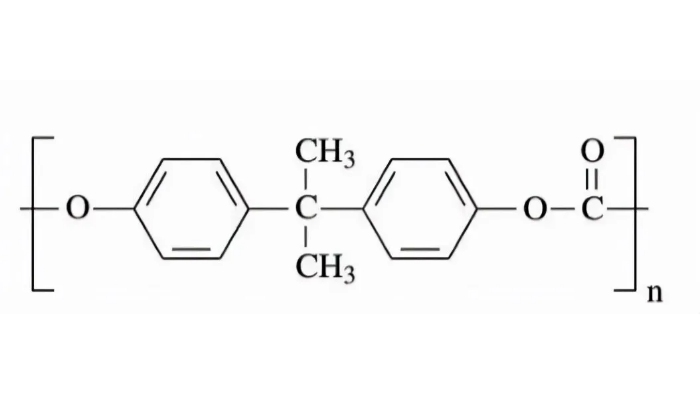
But in the eyes of modified materials engineers, BUG = opportunity.
So, what kind of modification results have been achieved in the industry so far? Next, let’s take Kumho Rili as an example to see if there is a breakthrough?
Living up to expectations, from the strict selection of base materials to the application of special additives, the Kumho Rili Plastics® team has launched this product after countless formula upgrades: PC/ABS HAC8250NH-NOCA.
So, what is the advantage of HAC8250NH-NOCA? PK with the modification results of mainstream domestic and foreign experts and companies, what is the result?
Without further ado, let’s look at the experimental data:
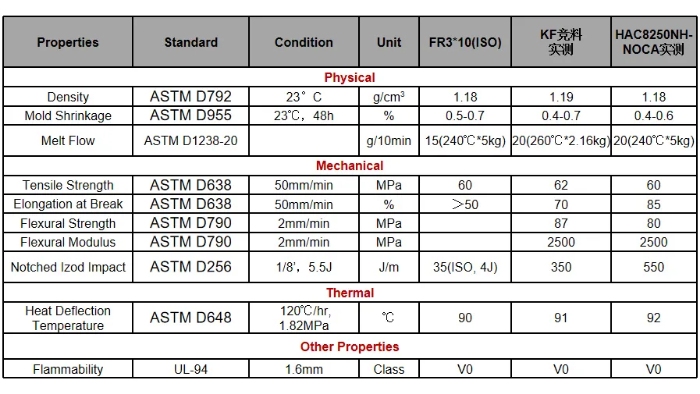
The results show that:
The shrinkage rate of HAC8250NH-NOCA is closer to that of metal;
The melt fluidity is better, reaching 20 (240℃*5kg), and the processing cost will be reduced a lot;
At the same time, the elongation at break is the best, at least 15+ higher, and the toughness is better;
In particular, the impact resistance is as high as 550.
So, HAC8250NH-NOCA, which looks so good, is also good in practical applications of screw column structures? And what about aging resistance?
We might as well verify it in practice:
Screw hole cracking scenario test:
No chemical exposure, stress-induced cracking of screw holesPut domestic and foreign competitive materials and conventional flame-retardant PC/ABS under the same conditions (same mold, same size screws, same torque...) to evaluate the following three cracking situations:
Directly drive in the screw - test the toughness;
Place the finished screw column board for 2 months - test the aging resistance
Immerse in glacial acetic acid solvent for 1 minute—test chemical resistance
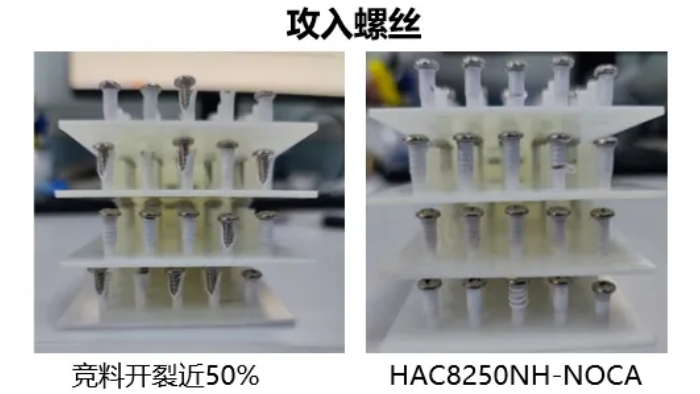
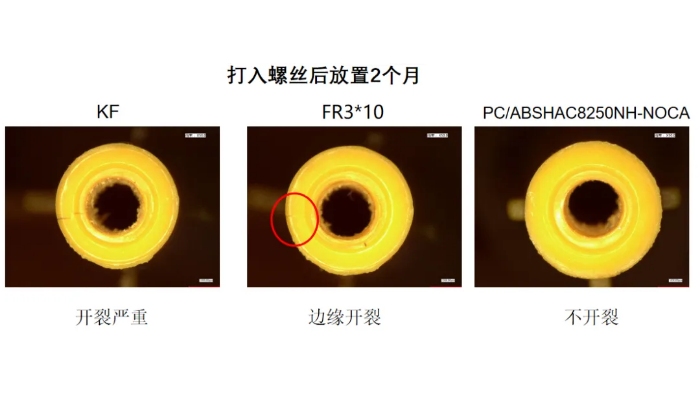
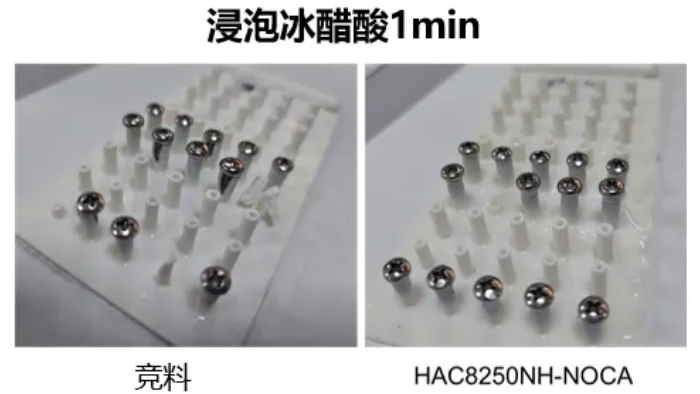
Obvious:
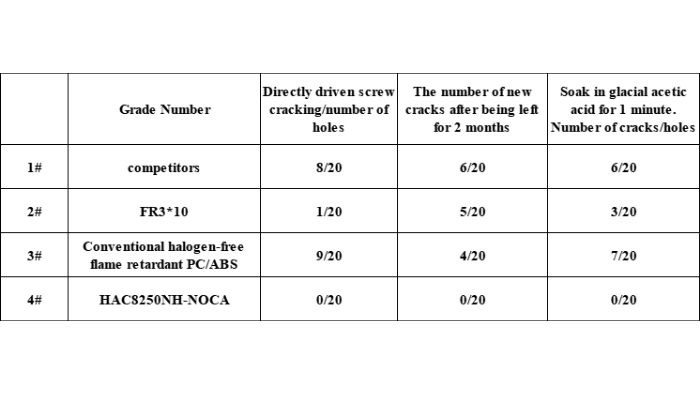
It is worthy of being the 0 cracking king that breaks out of the siege! Whether it is toughness, aging resistance, or chemical resistance, they all perform well, and it is the only one that achieves zero cracking!
It seems that the problem of screw column cracking is really solved. So, are there any materials that are better than blue?
3.Here comes the stronger king, this material does not crack and is more chemical resistant!
After more practice, we actually found a modified material with stronger chemical resistance, flame retardant PC/PBT.
This time, simply upgrade the difficulty by 5x.Soak the material in the highly corrosive glacial acetic acid solvent for 5 minutes before taking it out. We found:
Except for flame-retardant PC/PBT, other materials have fallen down one after another.
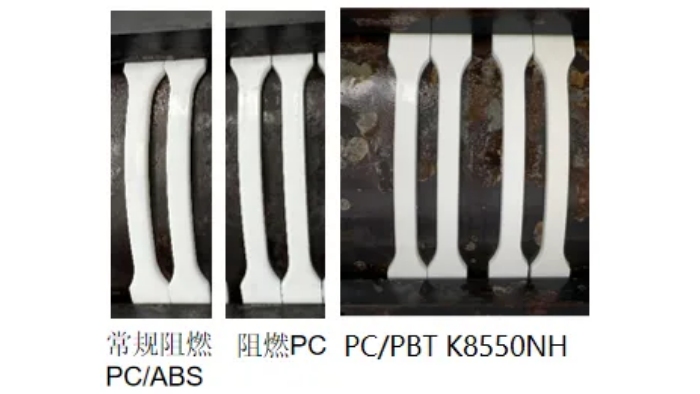
There are obvious silver cracks on the surface of conventional flame-retardant PC/ABS and flame-retardant PC splines. Even HAC8250NH-NOCA cannot guarantee 100% crack-free. However, no silver cracks appear on the surface of PC/PBT K8550NH splines.
Screw hole chemical resistance evaluation-customer terminal performance
Finally, let’s take a look at the effect of using PC/PBT K8550NH on the screw column structure of the customer terminal:
After soaking in glacial acetic acid for 5 minutes, drive screws into the screw posts and let them sit for 24 hours. What will happen?All I can say is that another 0 cracking king is born!
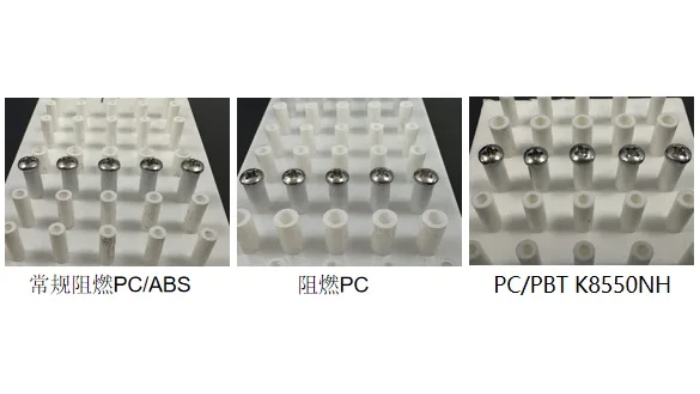
Of course, in addition to the highly corrosive glacial acetic acid test, we also tested the rust removal oil test that is inevitable during many assembly processes. As a result, PC/PBT was not afraid of it. It stood out from the competition and was better than its predecessor. blue.
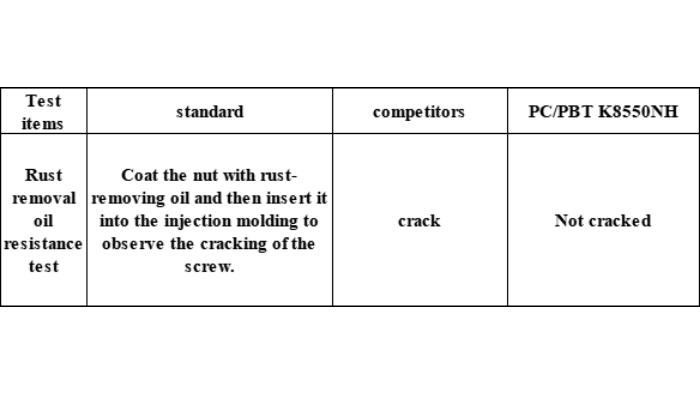
So, can flame-retardant PC/PBT with stronger chemical resistance compare with flame-retardant PC/ABS in terms of performance?
We have tested flame-retardant PC/PBT for all our customers. Except for poor dimensional stability and low elongation at break, other properties are comparable.
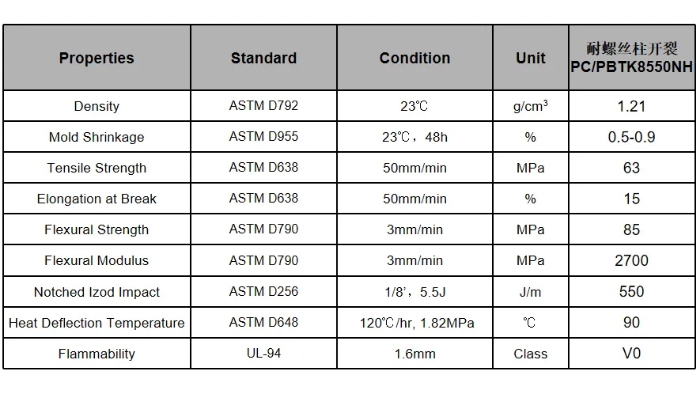
As for these two materials, how to choose:
Flame-retardant PC/ABS HAC8250NH-NOCA is more suitable for scenarios with higher dimensional stability and toughness requirements.
However, flame-retardant PC/PBT K8550NH is more suitable for parts with higher chemical resistance requirements and direct contact with chemical reagents.
If you also have the problem that PC/ABS alloy screw holes are prone to cracking, please feel free to consult QINGDAO PRIME UNION CO.,LTD.
QINGDAO PRIME TRADE CO., LTD is a company with more than 20 years of experience that specializes in distributing international brand engineering plastic particles. It mainly represents: CHIMEI ABS, HANWHA TOTAL PP, SABIC PPO, PC special materials, and Kumho Sunny. We also have our own modification processing factory, Qingdao Primetech Plastic Co., Ltd., with a professional technical team to provide you with fast and professional services to meet the needs of customers at different levels.
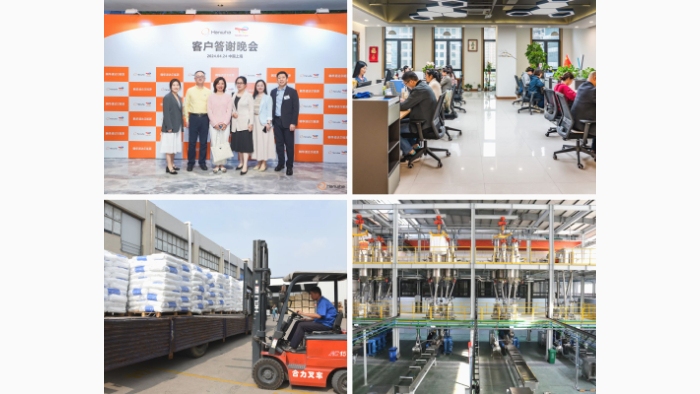

 English
English























